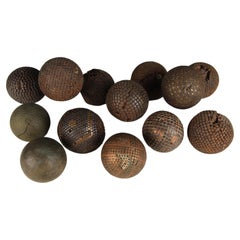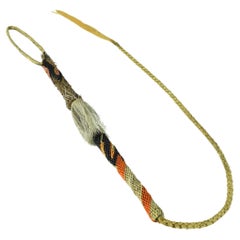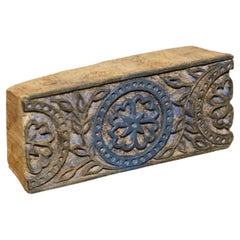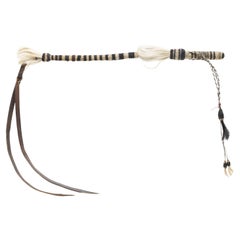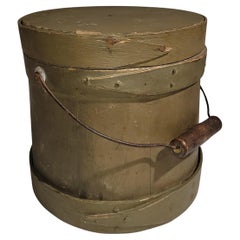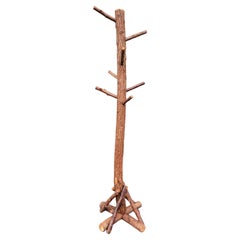Hand-Crafted Antiquities
to
20
145
61
210
1
41
40
5
4
3
2
2
2
2
1
1
50
109
51
1
31
13
1
1
4
2
5
3
1
1
129
74
46
31
31
120
46
37
32
28
211
211
211
1
1
1
1
1
Technique: Hand-Crafted
Large Set Of Antique Boule Balls, 13 Pieces, Pétanque, 1880s, France
Located in Greven, DE
Large Boule ball set of 13 pieces, France, late 19th Century.
Unrestored, original condition with signs of age and use.
In the 19th century, the manufacture of boules balls underwen...
Category
Late 19th Century French Late Victorian Antique Hand-Crafted Antiquities
Materials
Metal, Copper, Steel
1930s Deer Lodge Prison Horsehair Quirt
Located in Coeur d'Alene, ID
Deer Lodge Prison quirt with orange, black, and white dyed horsehair and leather hand strap and finely braided flapper.
PERIOD: Early 20th Century
ORIGIN: Montana, United States
SIZ...
Category
Early 20th Century American Hand-Crafted Antiquities
Materials
Other
Very Collectable Antique Hand Carved Blue Flower Printing Block for Wallpaper
Located in West Sussex, Pulborough
We are delighted to offer for sale this hand carved in sycamore wood printing block with blue flower detail
This piece is part of a suite, I ha...
Category
19th Century European Arts and Crafts Antique Hand-Crafted Antiquities
Materials
Sycamore
1930-40 Horsehair Quirt
Located in Coeur d'Alene, ID
Horsehair quirt with original leather flapper and buttons. Like new condition. From Montana. Whitish/cream and black stripes and braided horse hair.
PERIOD: First Half 20th Century
...
Category
Early 20th Century American Hand-Crafted Antiquities
Materials
Other
19Thc Original Painted Sage Green Sugar Bucket
Located in Los Angeles, CA
19Thc Original sage green painted sugar bucket from New England.The condition is very good and tight & sturdy.
Category
1870s American Adirondack Antique Hand-Crafted Antiquities
Materials
Wood
Rustic Old Hickory Hat & Coat Tree
Located in Los Angeles, CA
This folky hand made old hickory hat & coat rack is in fine condition and very sturdy.It is a hand made at home rack.
Category
Early 20th Century American Adirondack Hand-Crafted Antiquities
Materials
Wood
Set of Two Antique 19th Century Rural Altarpieces in Wood
Located in Leuven , BE
Set of two antique 19th C Rural Altarpieces in wood and with heavy encrusted patina
25,5 x 12,5 x 2,7 / 18,5 x 8 x 4 cm.
Category
Early 20th Century French Hand-Crafted Antiquities
Materials
Wood
Antique Boule Ball "B", Pétanque, 1880s, France, Craftsmanship
Located in Greven, DE
Beautiful, unique Boule ball, France, late 19th Century.
In the 19th century, the manufacture of boules balls underwent significant development in France as the game of boules, part...
Category
Late 19th Century French Late Victorian Antique Hand-Crafted Antiquities
Materials
Metal
Antique French Limestone Medicine Bowl
Located in Miami Beach, FL
Designed and produces, 18th century
Limestone
Measures: 8" height, 14.5" diameter
Provenance: Flea Market Paris.
Category
Early 18th Century French Neoclassical Antique Hand-Crafted Antiquities
Materials
Limestone
Pre Columbian Lambayeque Stirrup whistle Vessel South Latin American Antiques
Located in London, GB
Pre Columbian Sican Lambayeque Stirrup whistle Vessel
A most interesting stirrup whistle vessel of a man seated on top of a raft of storage vessel, ...
Category
15th Century and Earlier Peruvian Antique Hand-Crafted Antiquities
Materials
Pottery
Antique Boule Set, Boule Balls, Pétanque, 1880s, France, Craftsmanship
Located in Greven, DE
Beautiful, unique Boule set of two Boule balls and one target ball, France, late 19th century.
In the 19th century, the manufacture of boule balls underwent significant development ...
Category
Late 19th Century French Late Victorian Antique Hand-Crafted Antiquities
Materials
Olive
Collection of Six Hand Carved Butter Stamps
Located in Los Angeles, CA
Collection of six hand carved butter stamps
Tallest Stamp measures approx - 4.5 wide x 2.5 deep x 8 tall
shortest stamp measures approx - 2.5 tall x 4...
Category
19th Century American Adirondack Antique Hand-Crafted Antiquities
Materials
Wood
Antique Boule Ball Brass Decor, Pétanque, 1880s, France, Craftsmanship
Located in Greven, DE
Beautiful, unique Boule ball, France, late 19th Century.
In the 19th century, the manufacture of boules balls underwent significant development in France as the game of boules, part...
Category
Late 19th Century French Late Victorian Antique Hand-Crafted Antiquities
Materials
Metal, Brass
Antique Boule Ball "D F", Pétanque, 1880s, France, Craftsmanship
Located in Greven, DE
Beautiful, unique Boule ball, France, late 19th Century.
In the 19th century, the manufacture of boules balls underwent significant development in France as the game of boules, part...
Category
Late 19th Century French Late Victorian Antique Hand-Crafted Antiquities
Materials
Metal, Brass
Antique Boule Ball "P A", Pétanque, 1880s, France, Craftsmanship
Located in Greven, DE
Beautiful, unique Boule ball, France, late 19th Century.
In the 19th century, the manufacture of boules balls underwent significant development in France as the game of boules, part...
Category
Late 19th Century French Late Victorian Antique Hand-Crafted Antiquities
Materials
Metal
Original Painted Signed and dated 1818 Pantry Box
Located in Los Angeles, CA
19Thc Early & original painted signed & dated 1818 pantry box with the lid. This finely decorated pantry box is in very good condition.Probably from Europe.
Category
Early 19th Century Canadian Adirondack Antique Hand-Crafted Antiquities
Materials
Wood
Folk Art Hand Made Simplex 1909 Model Car in Copper and Brass 1940s
Located in Meer, VAN
Folk Art Hand Made Simplex 1909 Model Car in Copper and Brass, United States, 1940s.
This is really something very special. A one-off model car, made by a skilled craftsman around t...
Category
Early 20th Century North American American Craftsman Hand-Crafted Antiquities
Materials
Brass, Copper
Antique Boule Ball With Star Decor And C, Pétanque, 1880s, France, Craftsmanship
Located in Greven, DE
Beautiful, unique Boule ball, France, late 19th Century.
In the 19th century, the manufacture of boules balls underwent significant development in France as the game of boules, part...
Category
Late 19th Century French Late Victorian Antique Hand-Crafted Antiquities
Materials
Metal, Brass
Antique Boule Ball "6", Pétanque, 1880s, France, Craftsmanship
Located in Greven, DE
Beautiful, unique Boule ball, France, late 19th Century.
In the 19th century, the manufacture of boules balls underwent significant development in France as the game of boules, part...
Category
Late 19th Century French Late Victorian Antique Hand-Crafted Antiquities
Materials
Metal, Brass
Early 20th Century Swedish Folk Art Painted Wooden Lunch Box, circa 1910
Located in Valby, 84
This early 20th-century Swedish allmoge wooden lunch box, dating to around 1910, is a fine example of traditional Scandinavian folk craftsmanship. Pai...
Category
1910s Swedish Folk Art Vintage Hand-Crafted Antiquities
Materials
Iron
20th Century Sunflower Black Wrought Oversized Iron Hand Forged Andirons
Located in Essex, MA
20th century wrought iron hand forged black sunflower andirons with scrolled legs and hitching post loop in the middle these spectacular andirons measure. Tall. Lovely large size.
Category
Mid-20th Century American Hand-Crafted Antiquities
Materials
Wrought Iron
Antique Italian Art Glass Walking Cane
Located in Coeur d'Alene, ID
20th Century Italian art glass walking cane. 36". Cobalt blue knob, measures 2" diameter. White and red swirl, marching band baton. Excellent condition. Ex. Lambeth Estate, Highpoint NC.
PERIOD: 20th Century
ORIGIN: Italy, Europe
SIZE: 36" x 2"D
Check out our large selection of 19th and 20th Century canes including sword canes and gun canes...
Category
20th Century Italian Hand-Crafted Antiquities
Materials
Art Glass
Antique High Back Parlor Chair, France
Located in Antwerp, BE
French antique throne high back parlor chair with original floral upholstery and tacks. Carved wooden frame with scrolling floral motif dated 18...
Category
1870s French French Provincial Antique Hand-Crafted Antiquities
Materials
Upholstery, Wood
$1,211 Sale Price
20% Off
Genuine 1880s Albany Slip Glazed Anna Pottery Stoneware Pig Flask
Located in Coeur d'Alene, ID
Albany slip glazed Anna pottery stoneware pig flask by Wallace and Cornwall Kirkpatrick, Anna. Anatomically correct prone pig. In sized inscriptions "Fine Old Burmann Inn" and alongside "Lard Oil Drill". Underside flask opening under tail. Anna Pottery was s operative by the Kirkpatrick brothers between 1859 and 1896. They took part in art exhibitions such as Philadelphia Centennial in 1876 and the World's Columbian Exposition in Chicago 1893. In 1938 the first inscription of Anna pottery was published in the New York Historical Society. Pieces of Anna pottery pigs...
Category
1880s American Antique Hand-Crafted Antiquities
Materials
Pottery
$6,000 Sale Price
40% Off
Pair Of Antique Boule Balls "4", Pétanque, 1880s, France, Craftsmanship
Located in Greven, DE
Beautiful, unique Boule ball pair, France, late 19th Century.
Diameter 9,4 cm.
In the 19th century, the manufacture of boules balls underwent significant development in France as th...
Category
Late 19th Century French Late Victorian Antique Hand-Crafted Antiquities
Materials
Olive
Antique Boule Ball "7", Pétanque, 1880s, France, Craftsmanship
Located in Greven, DE
Beautiful, unique Boule ball, France, late 19th Century.
In the 19th century, the manufacture of boules balls underwent significant development in France as the game of boules, particularly the pétanque variant, gained in popularity. The manufacture of boules balls during this period was a manual process that required expertise, precision and love to detail.
In the late 19th and early 20th centuries, particularly in rural areas of France and other Mediterranean regions, olive wood was a commonly used source of material for making boules balls. This was not only due to the availability of the material, but also to the outstanding properties of olive wood, which was characterized by hardness, strength and a rich grain.
First, the olive wood was carefully selected and shaped into raw balls, which were then sanded to the desired size and shape. The nails were then hammered into the balls one by one, making sure that they were evenly distributed and firmly anchored. Finally, the spheres were polished and coated with a protective varnish to enhance their natural beauty and protect them from the elements.
The use of nails to decorate and reinforce olive wood boules was a traditional practice that not only gave the ball a rustic aesthetic, but also improved its durability and contributed to customization. Many balls were made according to the specific requirements and preferences of the players. Nails were driven at regular intervals around the ball, with each nail hole precisely placed so as not to affect the balance and weight distribution of the ball. These nails not only served as a decorative element, but also helped to strengthen the structure of the ball and make it more resistant to the hard knocks and wear and tear during play. Individual engravings or decorations were often applied to the balls to make them unique and identify the player.
Antique boules...
Category
Late 19th Century French Late Victorian Antique Hand-Crafted Antiquities
Materials
Metal
Antique Folk Art Miniature Rocking Horse in Painted Wood
Located in Meer, VAN
Antique Folk Art Horse in Painted Wood, Europe, 19th century.
This is a beautiful and hand made antique folk art rocking horse in wood and weat...
Category
19th Century European Folk Art Antique Hand-Crafted Antiquities
Materials
Wood
Original 18th Century Tyrolean Spinning Wheel in Walnut, Still Working
Located in Vigonza, Padua
A museum tool, made entirely by hand that recalls the peasant culture of the past.
Category
18th Century Austrian Antique Hand-Crafted Antiquities
Materials
Walnut
Copper Ottoman Empire Coffee Pot or Tea Kettle, Early 20th century
Located in Lomita, CA
This Ottoman Empire copper kettle has a beautiful patina and the Ottoman mark built into the handle. This is part of a collection of Ottoman pieces from Istanbul that includes artifa...
Category
Early 20th Century Other Hand-Crafted Antiquities
Materials
Copper
$391 Sale Price
20% Off
Edwardian English Trapeze Artist Set
Located in London, GB
Edwardian Trapeze artist set
We share what we love, and we love this rare and unusual set of late 19th century English trapeze artists equipment. Housed in its original pine box, this collection includes a pair of leather stitched rings, ceiling screw supports, cast metal foot supports with rope...
Category
1910s British Edwardian Vintage Hand-Crafted Antiquities
Materials
Pine
Folk Art Chair from Finland ca 1930
Located in Farsta, SE
Folk Art chair from Finland ca 1930s
Made of Acid-stained Pine Wood
Consistent with age and use.
I call it mini Sauron throne.. One of a kind!
Height: ...
Category
1930s Finnish Folk Art Vintage Hand-Crafted Antiquities
Materials
Pine
Pair Of Antique Boule Balls "G", Pétanque, 1880s, France, Craftsmanship
Located in Greven, DE
Beautiful, unique Boule ball pair, France, late 19th Century.
In the 19th century, the manufacture of boules balls underwent significant development in France as the game of boules,...
Category
Late 19th Century French Late Victorian Antique Hand-Crafted Antiquities
Materials
Olive
19th Century Swedish Folk Art Wooden Trough/ Serving Bowl with Original Paint
Located in Boden, SE
19th Century Swedish Antique wooden tray / serving bowl with untouched Original Paint from Skellefteå Västerbotten, Northern Sweden.
A large farmer...
Category
Mid-19th Century Swedish Folk Art Antique Hand-Crafted Antiquities
Materials
Pine
Collection of Swedish wooden barrels from the 18th century
Located in Valby, 84
Rare collection of seven wooden folk art barrels from Sweden from the 18th century in original condition with signs of use.
These barrels were found in the north of Sweden.
Some of t...
Category
19th Century Swedish Folk Art Antique Hand-Crafted Antiquities
Materials
Wood
Swedish Folk Art Root Basket, Sweden 19th century
Located in Grythyttan, SE
Introducing a remarkable piece of history that transcends time - the exquisite Swedish 19th century root basket. Most likely made of birch root. Immerse yourself in the rich craftsma...
Category
19th Century Swedish Folk Art Antique Hand-Crafted Antiquities
Materials
Birch
Antique Boule Ball "J P", Pétanque, 1880s, France, Craftsmanship
Located in Greven, DE
Beautiful, unique Boule ball, France, late 19th Century.
In the 19th century, the manufacture of boules balls underwent significant development in France as the game of boules, part...
Category
Late 19th Century French Late Victorian Antique Hand-Crafted Antiquities
Materials
Metal, Brass
Antique Boule Balls Set "B", Pétanque, 1880s, France, Craftsmanship
Located in Greven, DE
Beautiful, unique Boule set of three Boule balls, France, late 19th Century.
In the 19th century, the manufacture of boules balls underwent significant development in France as the game of boules, particularly the pétanque variant, gained in popularity. The manufacture of boules balls during this period was a manual process that required expertise, precision and love to detail.
In the late 19th and early 20th centuries, particularly in rural areas of France and other Mediterranean regions, olive wood was a commonly used source of material for making boules balls. This was not only due to the availability of the material, but also to the outstanding properties of olive wood, which was characterized by hardness, strength and a rich grain.
First, the olive wood was carefully selected and shaped into raw balls, which were then sanded to the desired size and shape. The nails were then hammered into the balls one by one, making sure that they were evenly distributed and firmly anchored. Finally, the spheres were polished and coated with a protective varnish to enhance their natural beauty and protect them from the elements.
The use of nails to decorate and reinforce olive wood boules was a traditional practice that not only gave the ball a rustic aesthetic, but also improved its durability and contributed to customization. Many balls were made according to the specific requirements and preferences of the players. Nails were driven at regular intervals around the ball, with each nail hole precisely placed so as not to affect the balance and weight distribution of the ball. These nails not only served as a decorative element, but also helped to strengthen the structure of the ball and make it more resistant to the hard knocks and wear and tear during play. Individual engravings or decorations were often applied to the balls to make them unique and identify the player.
Antique boules...
Category
Late 19th Century French Late Victorian Antique Hand-Crafted Antiquities
Materials
Olive
Antique Boule Ball "17", Pétanque, 1880s, France, Craftsmanship
Located in Greven, DE
Beautiful, unique Boule ball, France, late 19th Century.
In the 19th century, the manufacture of boules balls underwent significant development in France as the game of boules, part...
Category
Late 19th Century French Late Victorian Antique Hand-Crafted Antiquities
Materials
Metal
Antique Boule Ball "62", Pétanque, 1880s, France, Craftsmanship
Located in Greven, DE
Beautiful, unique Boule ball, France, late 19th Century.
In the 19th century, the manufacture of boules balls underwent significant development in France as the game of boules, part...
Category
Late 19th Century French Late Victorian Antique Hand-Crafted Antiquities
Materials
Metal
Swedish Birch hook 1886
Located in Farsta, SE
A large pine hook made in 1886 in Sweden is a historical tool used for various purposes. Pine or birch hooks, often made from a sturdy piece of wood, were commonly used in agricultur...
Category
1880s Swedish Scandinavian Modern Antique Hand-Crafted Antiquities
Materials
Birch
Turn of The Century "Clown" Themed Chocolate Mold Pattern Germany Circa 1910
Located in Incline Village, NV
Turn of the century chocolate mold pattern was used in the making of chocolate in the shape of a clown circa 1900; which was the dawn of chocolate manufacturing in Europe. To capital...
Category
1910s German Folk Art Vintage Hand-Crafted Antiquities
Materials
Metal
Antique Handcrafted and Stable Solid Oak & Great Patina Joint Stool Or Table
Located in Lisse, NL
Solid oak joint stool, great shape and beautiful color.
This handcrafted joint stool seat is both rustic and stylish. It is an absolute joy to watch and to sit on. It is as stabile ...
Category
1890s European Renaissance Revival Antique Hand-Crafted Antiquities
Materials
Oak
Tall Brass and Iron Shoehorn Mid-Century Modern
Located in Vienna, AT
For sale is a nice tall shoehorn. It was made from iron which has been painted black, embellished with brass elements and a bright red leather wrapping on the handle. It is represent...
Category
Mid-20th Century Austrian Mid-Century Modern Hand-Crafted Antiquities
Materials
Brass, Iron
Historical Austrian Alps Goatbells, circa 1900
Located in Vienna, AT
In this ad you get the chance to buy a really rare antique. The object for sale is a bundle of historic goatbells used in Austria and Southern Germany on goats and small live stock w...
Category
Late 19th Century Austrian Antique Hand-Crafted Antiquities
Materials
Bronze
Victorian Brass Magazine Rack, Lion Feet, 19th Century
Located in Antwerp, BE
Quality Antique Victorian brass and mahogany revolving magazine stand having a shaped brass handle to the centre, four sections for magazines with b...
Category
1860s English Victorian Antique Hand-Crafted Antiquities
Materials
Bronze
$1,583 Sale Price
20% Off
Cowbell with Hand Woven Braided Leather Collar
Located in Los Angeles, CA
A vintage cowbell made of Steel, metal, and braided leather or the collar.
This is a great decorative piece, however the bell works great. A great place to put this is over a door knob, allowing one to know when the door opens or moves... Also a great tracking device for your significant other.
The patina is wonderful and it reminds one of a Ralph Lauren Ranch...
Category
20th Century Rustic Hand-Crafted Antiquities
Materials
Steel
1800s Norwegian folk art Box, Hand-carved by Ole Olsen Moene (1839-1908)
Located in Skien, NO
Exceptional 19th Century Norwegian Folk Art Tobacco Box by Ole Olsen Moene - Museum Quality
This remarkable 19th-century Norwegian folk art tobacco box, dating from the late 1800s, ...
Category
Late 19th Century Norwegian Folk Art Antique Hand-Crafted Antiquities
Materials
Birch, Nutwood, Beech, Bentwood
Antique Boule Ball "G", "J", Pétanque, 1880s, France, Craftsmanship
Located in Greven, DE
Beautiful, unique Boule ball, France, late 19th Century.
Decorated with the initials "G" and "J".
In the 19th century, the manufacture of boules balls underwent significant developm...
Category
Late 19th Century French Late Victorian Antique Hand-Crafted Antiquities
Materials
Olive
Pair Of Antique Boule Balls Circle, Pétanque, 1880s, France, Craftsmanship
Located in Greven, DE
Beautiful, unique Boule ball pair and one target ball, France, late 19th Century.
In the 19th century, the manufacture of boules balls underwent significant development in France as...
Category
Late 19th Century French Late Victorian Antique Hand-Crafted Antiquities
Materials
Olive
18th Century Swedish Decorated Mangle Board
Located in Kramfors, SE
Folk art mangle board from northern Sweden. This is a typical proposal gift to the would-be bride from the groom. If he had the skill the groom would make...
Category
Late 18th Century Swedish Folk Art Antique Hand-Crafted Antiquities
Materials
Pine
LATE 17th CENTURY EMBOSSED BRASS FOOD WARMER
Located in Firenze, FI
Ancient brass food warmer, worked and embossed by hand, characterized by an elegant and refined style. It has a round body supported by a ring foot, a lid with a handle and two handl...
Category
Late 17th Century Italian Antique Hand-Crafted Antiquities
Materials
Brass
Antique Boule Ball "G", Pétanque, 1880s, France, Craftsmanship
Located in Greven, DE
Beautiful, unique Boule ball, France, late 19th Century.
In the 19th century, the manufacture of boules balls underwent significant development in France as the game of boules, particularly the pétanque variant, gained in popularity. The manufacture of boules balls during this period was a manual process that required expertise, precision and love to detail.
In the late 19th and early 20th centuries, particularly in rural areas of France and other Mediterranean regions, olive wood was a commonly used source of material for making boules balls. This was not only due to the availability of the material, but also to the outstanding properties of olive wood, which was characterized by hardness, strength and a rich grain.
First, the olive wood was carefully selected and shaped into raw balls, which were then sanded to the desired size and shape. The nails were then hammered into the balls one by one, making sure that they were evenly distributed and firmly anchored. Finally, the spheres were polished and coated with a protective varnish to enhance their natural beauty and protect them from the elements.
The use of nails to decorate and reinforce olive wood boules was a traditional practice that not only gave the ball a rustic aesthetic, but also improved its durability and contributed to customization. Many balls were made according to the specific requirements and preferences of the players. Nails were driven at regular intervals around the ball, with each nail hole precisely placed so as not to affect the balance and weight distribution of the ball. These nails not only served as a decorative element, but also helped to strengthen the structure of the ball and make it more resistant to the hard knocks and wear and tear during play. Individual engravings or decorations were often applied to the balls to make them unique and identify the player.
Antique boules...
Category
Late 19th Century French Late Victorian Antique Hand-Crafted Antiquities
Materials
Metal
Dutch Wood Framed Mural Of “Azulejos”
Located in Guaynabo, PR
This is a Dutch Wood Framed Mural Of “Azulejos” or White and Blue Tiles. It depicts three rows of tiles and each one consists of three different tiles...
Category
19th Century Dutch Folk Art Antique Hand-Crafted Antiquities
Materials
Earthenware
Antique Boule Ball, Pétanque, 1880s, France, Craftsmanship
Located in Greven, DE
Beautiful, unique Boule ball, France, late 19th Century.
In the 19th century, the manufacture of boules balls underwent significant development in France as the game of boules, part...
Category
Late 19th Century French Late Victorian Antique Hand-Crafted Antiquities
Materials
Metal
Pair Of Antique Boule Balls, Pétanque, 1880s, France, Craftsmanship
Located in Greven, DE
Beautiful, unique Boule ball pair and one target ball, France, late 19th Century.
In the 19th century, the manufacture of boules balls underwent significant development in France as...
Category
Late 19th Century French Late Victorian Antique Hand-Crafted Antiquities
Materials
Metal
Antique Boule Ball With Flower Decor, Pétanque, 1880s, France, Craftsmanship
Located in Greven, DE
Beautiful, unique Boule ball, France, late 19th Century.
In the 19th century, the manufacture of boules balls underwent significant development in France as the game of boules, part...
Category
Late 19th Century French Late Victorian Antique Hand-Crafted Antiquities
Materials
Metal, Brass
Pair Of Antique Boule Balls, Pétanque, 1880s, France, Craftsmanship
Located in Greven, DE
Beautiful, unique Boule ball pair, France, late 19th Century.
Diameter 9,5 cm.
In the 19th century, the manufacture of boules balls underwent significant development in France as the game of boules, particularly the pétanque variant, gained in popularity. The manufacture of boules balls during this period was a manual process that required expertise, precision and love to detail.
In the late 19th and early 20th centuries, particularly in rural areas of France and other Mediterranean regions, olive wood was a commonly used source of material for making boules balls. This was not only due to the availability of the material, but also to the outstanding properties of olive wood, which was characterized by hardness, strength and a rich grain.
First, the olive wood was carefully selected and shaped into raw balls, which were then sanded to the desired size and shape. The nails were then hammered into the balls one by one, making sure that they were evenly distributed and firmly anchored. Finally, the spheres were polished and coated with a protective varnish to enhance their natural beauty and protect them from the elements.
The use of nails to decorate and reinforce olive wood boules was a traditional practice that not only gave the ball a rustic aesthetic, but also improved its durability and contributed to customization. Many balls were made according to the specific requirements and preferences of the players. Nails were driven at regular intervals around the ball, with each nail hole precisely placed so as not to affect the balance and weight distribution of the ball. These nails not only served as a decorative element, but also helped to strengthen the structure of the ball and make it more resistant to the hard knocks and wear and tear during play. Individual engravings or decorations were often applied to the balls to make them unique and identify the player.
Antique boules...
Category
Late 19th Century French Late Victorian Antique Hand-Crafted Antiquities
Materials
Olive
Cranberry Bog Harvester Rake Scoop
Located in Los Angeles, CA
A beautifully patinated cranberry rake.
The Rake is a decorative piece and a compliment to many spaces. Hanging on a wall, sitting on a console table ...
Category
20th Century North American American Classical Hand-Crafted Antiquities
Materials
Wire
Native Salmon Ladder Maquette
Located in Coeur d'Alene, ID
Salmon ladder/rattle maquette by Lillian Pitt (1943 Wasco). Made of copper tubing and hanging cut copper salmon. Maquette for public commission at the Uni...
Category
Mid-20th Century American Native American Hand-Crafted Antiquities
Materials
Copper
19th Century English Quirky Country House Fire Escape
Located in London, GB
19th century English country house fire escape
We are proud to offer a rare example of a 19th century quirky county house fire escape, once of the Fasque House, Fettercaine Estate, ...
Category
1890s British Early Victorian Antique Hand-Crafted Antiquities
Materials
Wood
Recently Viewed
View AllMore Ways To Browse
Rolling Buffet
Round Drinks Trolley
Round Gate Leg Table
Round Tray Enamel
Royal Bavarian
Royal Delft Porcelain
Royal Doulton Lambeth
Royal Vienna Urn
Rstk Vase
Russian Cutlery
Scandinavian Monkey
Shagreen Vanity Mirror
Ship Wreck Chinese
Southwestern Pottery
Spelter Figurine
Spode Bird
Squiggle Table
St Anthony Gold
